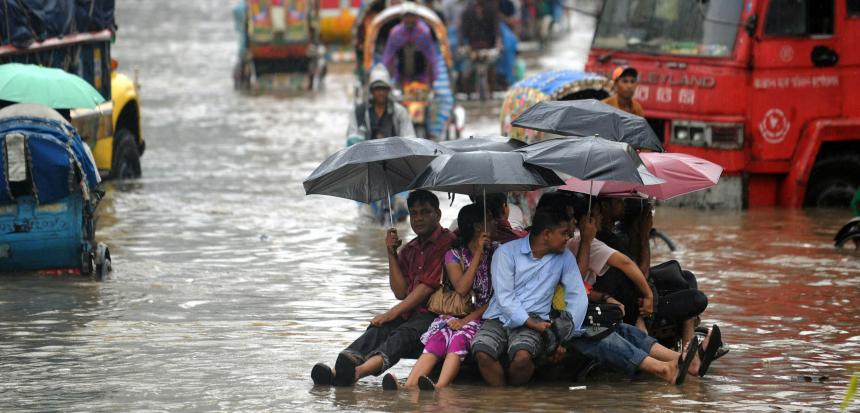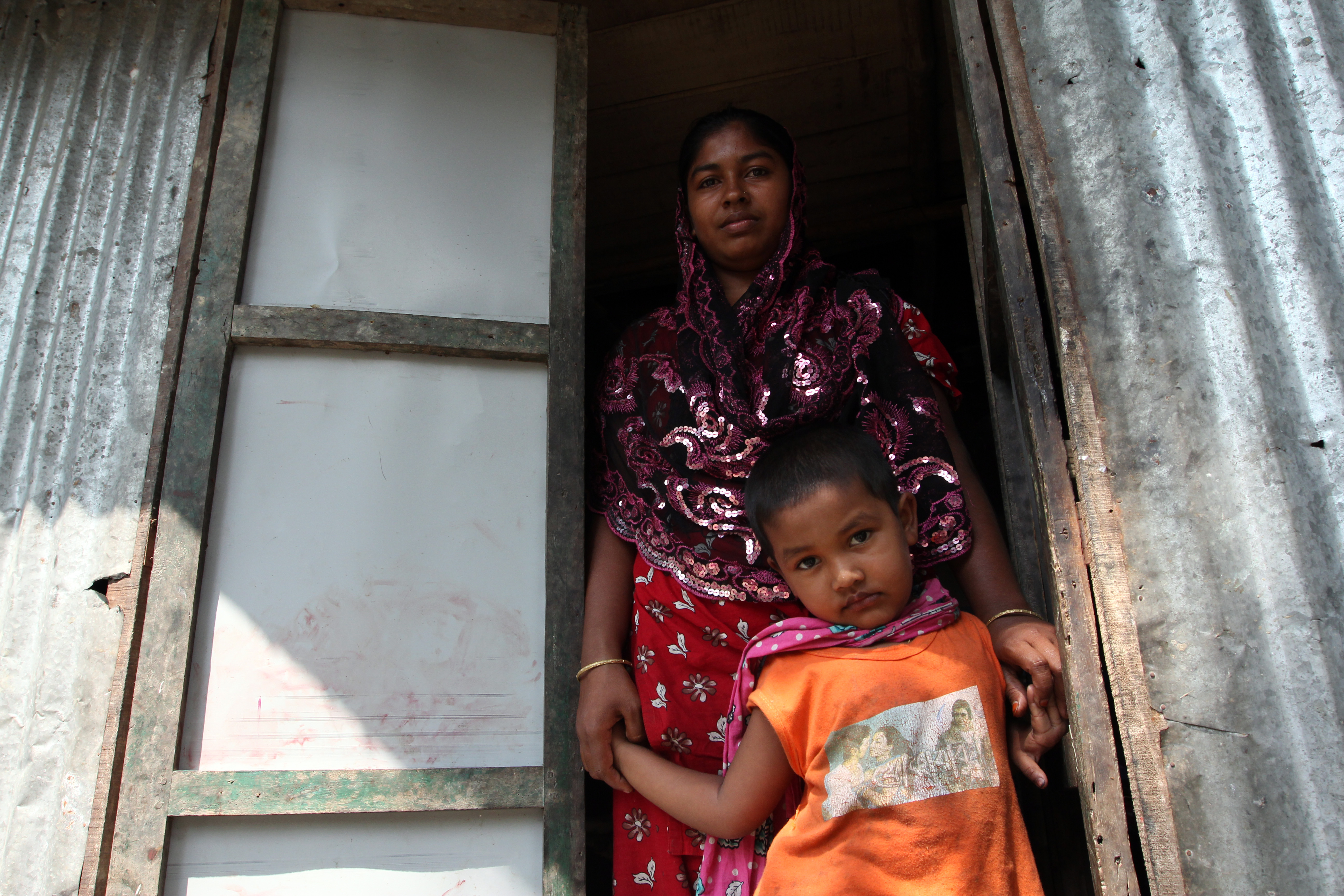
DHAKA, Bangladesh — Dobir Uddin remembers sitting on the riverbank near his farm in southern Bangladesh, admiring the puffy clouds scuttling across a big sky, the feel of a rain-scrubbed breeze on his face. Raindrops would lure fish from the river's depths. If he sat still, very still, he could catch one with his bare hands.
"I had everything at home," Uddin says, sitting on the bed of his one-room shanty in a Dhaka slum. Now, he says, he feels like he's "trapped in a cage."
The skinny 42-year-old, his beard and hair dyed orange-red with henna, struggles with fatigue, a wracking cough, and the depressing pall of pollution that hangs over the city skyline. When he can muster the strength, he pedals a rickshaw carrying passengers through Dhaka's chaotic, exhaust-choked streets, so he can earn money to buy rice and lentils for his family and pay rent on the corrugated-metal shack where they live.
Dhaka is the world's most densely populated megacity, with more than 15 million people as of 2011, the most recent year for which a number is available. The overstuffed metropolis struggles to accommodate its current residents. Power outages and blackouts are frequent. The streets are clogged. Sewage pipes, when they exist at all, often back up and spill into the streets.
Despite its dysfunctions, Dhaka is packing in more people every day. Precise numbers are elusive, but tens of thousands of rural migrants arrive every month, crowding into its slums, according to demographers at the nonprofit Population Council. Some newcomers are following the global pattern of urban migration, lured by the opportunity of the big city when the family farm has been subdivided so many times among sons that the parcels are too small to support the family.
Many more arrive in the capital with no other place to go. They are forced from their homes, fleeing droughts, floods, and other ravages of a changing climate. Uddin and others are part of a new wave of environmental refugees that experts predict will swell into the tens of millions by midcentury, due to elevated temperatures, rising seas, and violent weather. Half of Bangladesh's population lives less than 17 feet above sea level, putting this country at the forefront of this harrowing development.
The path that brought Uddin and his family to Dhaka has become crowded. Uddin was surprised at the familiar faces he saw on the ferry that carried him upriver from the southern district of Barisal. Most of his new neighbors in the Bou Bazar slum also come from rural areas to the south.
It took a lot to pry Uddin from his land. Bangladeshi farmers are renowned for their resilience. They are masters at adapting to storms from the sea, floodwaters from swollen rivers, wilting heat that can sap the strength of farmers and their crops. That kind of adaptation is necessary on the vast flood plain that stretches as flat and green as a pool table to the Bay of Bengal.
Barisal takes pride in its reputation as the granary of Bangladesh. The fertile delta has long taken its nourishment from the water and nutrient-rich sediment from the Himalayas washing down the Ganges, the Brahmaputra, and 800 other rivers and tributaries that braid their way to the sea.
Uddin's farm was located next to one of these tributaries. Like his father, he dug and maintained canals to divert floodwaters during the monsoon season, which lasts from June to October, to flood his rice paddy when he wanted it and drain his land when needed.
His farm was tiny, less than a quarter-acre, because he inherited only a fraction of his father's land. The rest was divided among his three brothers. He made up for it with hard work. He coaxed four crops a year from his tiny parcel of land: Two crops of rice during the monsoons, and two crops of lentils during the dry season, irrigating from well water. By trading some rice and lentils for vegetables and a little meat, he was able to provide for himself, his wife, their son, and their three daughters.
Then an insidious change began to undermine Uddin's livelihood and his resolve: encroaching salt water from rising seas.
About a dozen years ago, Uddin says, his crops began producing less and less. The pink lentils he grew emerged ashen gray. His rice stalks came up pale and yellow, not the usual deep green. Disease and insects attacked the salt-weakened plants.
"The land itself changed," Uddin says. "It used to be muddy. It became more dusty." A landscape frosted with salt residue. When he could no longer grow enough food to feed his family, he borrowed money from a loan shark. Then, to pay his debts, he began to sell off part of his land.
Sea levels have risen slowly -- roughly 8 inches globally -- over the last century as a result of the buildup of heat-trapping gases in the atmosphere. The pace has picked up, nearly doubling since 1993, according to the Intergovernmental Panel on Climate Change.
Scientists forecast that if high greenhouse gas emissions continue, sea levels could rise another 3 feet, possibly much more, by the year 2100. So far, half of the rise has come from expanding oceans -- warmer water takes up more space -- due to seawater absorbing the extra heat in the atmosphere. The other half has come from melting mountain glaciers and ice sheets near the poles. Predicting future melt is an inexact science, leaving wide uncertainty about how much meltwater will pour into the oceans off Greenland and Antarctica.
By midcentury, as many as 1 billion people will find their lives disrupted -- and even might be permanently forced from their homes -- due to flooding and other climatic events, according to the International Organization for Migration. Yet it's easy to set aside such worries and postpone action because, despite the occasional destructive storm, the threats remain in the distant, hazy future.
Bangladesh offers a preview of a hotter, crowded world forced to deal with climate disruptions. From its perch on the Bay of Bengal, this country of 160 million people is considered one of the most vulnerable to climate change due to multiple factors: population density, poverty, and topography.
A 3-foot rise in seas would leave 17.5 percent of the country underwater and extend the reach of salt water up tidal rivers even farther inland during the dry season. In addition to spoiling farmland and sources of fresh water, it could increase outbreaks of cholera, said Peter Kim Streatfield, director of the Centre for Population, Urbanization and Climate Change at the International Centre for Diarrhoeal Disease Research, Bangladesh.
Some island nations, such as the Maldives, Kiribati, and Tuvalu, face an existential threat of becoming uninhabitable or disappearing beneath the waves. The difference with Bangladesh is how many more people live in harm's way. In the Maldives, leaders expect their 380,000 citizens will have to move at some point this century. In Bangladesh, the government estimates that as many as 25 million people will be permanently displaced if one-fifth of the country becomes inundated by a 3-foot rise in the seas, as scientists predict.
"It will be the biggest mass migration in history," says Maj. Gen. A.N.M. Muniruzzaman, a retired Army officer who is now president of the Bangladesh Institute of Peace and Security Studies in Dhaka. His country, he said, is not prepared to handle the basic food, water, and sanitation needs of so many displaced people.
Meanwhile, population growth adds to the pressure. The country's population is projected to reach more than 200 million by midcentury. The growth is not a result of high birthrates. The government has developed a successful family-planning program, resulting in a drop in fertility from an average of seven children per woman in the 1970s to slightly more than two children today. Instead, the growth comes from sheer population momentum, as millions of young couples enter their childbearing years. Even if they hold themselves to two children apiece, the United Nations projects that another 43 million people will be packed into a country about the size of Iowa.
In the Barisal region alone, more than half the farmland has become too laden with salt for growing traditional rice, according to researchers at the International Rice Research Institute in Bangladesh. Farmers have abandoned this land, uprooting their families and moving to cities.
Dhaka has taken up the most. Its migrant population grows by 6 percent a year, averaging several thousand arrivals a day, said Ubaidur Rob, country director for the Population Council in Bangladesh. Migrants don't file into the city in an orderly way. They come in pulses, often following the devastation of a killer storm.
Uddin was working in his rice fields on Nov. 15, 2007, when he noticed the first breath of wind. It picked up fast, furiously shaking the trees.
He looked up and noticed an advancing wall of water coming up the river. It was just a few hundred yards away. He ran to the house to find his wife and children. The first wave of water raced past him and beat him to it, lashing up and over the threshold.
He heard his wife scream and found her cowering inside. "I realized," he says, "that if we stay here now, everyone will die."
He gathered up his children to make a break for higher ground. He hoisted Tonni, his youngest daughter, onto his shoulders. He tucked Suraya, the second-youngest, under an arm and led the family through the roiling waters. It was a long, slow slog -- about 500 yards before they reached the school that sat atop a mound of silt and had become the de facto shelter for villagers and surrounding farmers.
Cyclone Sidr, which forced Uddin from his home, has been blamed for the deaths of 3,500 people and the displacement of more than 2 million.
Uddin's family and neighbors spent five days at the school, stranded on its hilltop grounds that rose above the floodwaters like an island. His eldest child and only son, Abul Uddin, was thirsty and drank contaminated water. Soon he grew sick and weak. No help came. His family was powerless. They watched him die of cholera four days after the storm. He was 14.
Uddin collapses on the bed in his 10-foot-by-10-foot shanty, reliving the story. Tears flow. His slender chest heaves with silent sobs. His son's death left the family lost and broken. On this day, like many others, he will try to summon the strength to climb on his cycle rickshaw and join 400,000 other rickshaw pushers competing on the streets of Dhaka.

Education Resource
Journalist Ken Weiss on Population Growth
The overcrowded slums of Dhaka, Bangladesh, are just the latest stop for Ken Weiss on his journey to...





